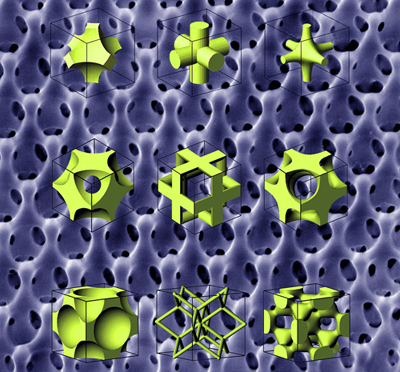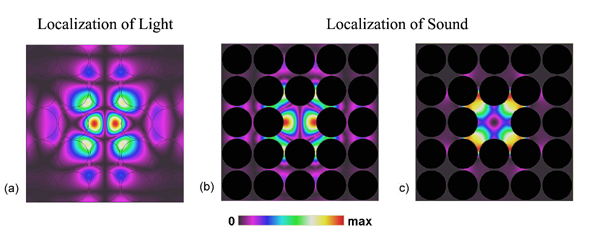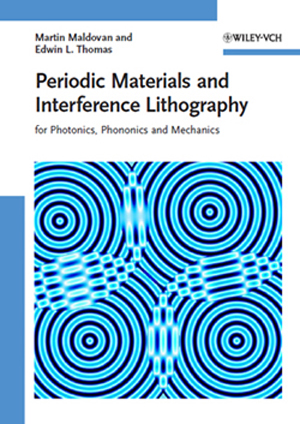© 2016 Georgia Institute of Technology
Past Research
Book: Periodic Materials and Interference Lithography for Photonics, Phononics, and Mechanics
Periodic materials have been demonstrated to have unique physical properties due to their singular interaction with waves. In recent years, the discovery of an experimental technique called interference lithography, which can create periodic materials at very small length scales, had a strong impact on the way we think about these materials. In order to rationally design and fabricate periodic materials by interference lithography, it is useful to perceive a periodic material as a sum of its Fourier series components. This book studies the correlation between the analytical description of periodic materials by Fourier series and the experimental realization of these materials by interference lithography. We believe this mutual relation will have a deep influence in the development of new periodic materials since the convergence of theoretical and experimental methods allows for the theoretical design of structured materials that can be experimentally realized. The book also attempts to comprehensively study the applications of periodic materials. For example, in spite of their strong similarities, to date, photonic and phononic crystals have been studied separately. We try to integrate these two research areas by proposing photonic-phononic crystals that can combine the physical properties of these materials and may even give rise to unique acousto-optical applications. The ubiquity of periodic materials in science and technology can be demonstrated by the large number of physical processes they can control. Several of these practical applications for periodic materials are discussed in this book, which include the control of electromagnetic and elastic waves, mechanics, fluids, and heat. The broad range of applications demonstrates the multifunctional character of periodic materials and the strong impact they can have if fabricated at small length scales.
Mechanical Properties of Microframes fabricated by Interference Lithography

The ubiquity of multifunctional cellular solids in both nature and engineered structures is a clear indication of the importance of such materials. Cellular solids occur for example as bones and exoskeletons, catalytic support material, optimized composites, scaffolds for cell growth and trusses. The mechanical behavior of these structures is the most common critical functionality across all these examples. The establishment of the relationship between topology and performance has been identified as representing the research frontier. Beyond this lies the challenge of the development of a fabrication technique that will afford control over topology with the required specificity. At submicron length scales this is an even greater challenge. The prospect of making such complex 3D structures at the submicron scale is an exciting one, since structures at these length scales allow access to novel length scale dependent mechanical properties. It is thus important to establish the effective elastic properties of periodic bicontinuous solid/air structures that can be fabricated at small length scales by interference lithography and compare their properties with standard models.
More details here.
Simultaneous Localization of Light and Sound (Phoxonic Crystals/Optomechanics)
 The localization of light by purposely introducing structural defects in a otherwise perfectly periodic structure is a physical phenomenon that is not exclusive to electromagnetic waves. In fact, many of the physical effects obtained for electromagnetic waves by using photonic crystals can similarly be obtained for mechanical waves by using phononic crystals. An interesting and novel research area is to design periodic structures that can localize both light and sound in the same spatial region at the same time. This can enhance the interaction between photons and phonons and create non-conventional acoustic-optical devices. In order to obtain the simultaneous localization of light and sound in the same area, it is essential to create periodic structures possessing both complete photonic and phononic band gaps. These "blind and deaf" structures (also known as Phoxonic Crystals or Optomechanical Crystals) can integrate the simultaneous management of electromagnetic and mechanical waves and enhance their mutual interaction.
The localization of light by purposely introducing structural defects in a otherwise perfectly periodic structure is a physical phenomenon that is not exclusive to electromagnetic waves. In fact, many of the physical effects obtained for electromagnetic waves by using photonic crystals can similarly be obtained for mechanical waves by using phononic crystals. An interesting and novel research area is to design periodic structures that can localize both light and sound in the same spatial region at the same time. This can enhance the interaction between photons and phonons and create non-conventional acoustic-optical devices. In order to obtain the simultaneous localization of light and sound in the same area, it is essential to create periodic structures possessing both complete photonic and phononic band gaps. These "blind and deaf" structures (also known as Phoxonic Crystals or Optomechanical Crystals) can integrate the simultaneous management of electromagnetic and mechanical waves and enhance their mutual interaction.
Featured on cover of Applied Physics Letters

More details here:
Simultaneous localization of photons and phonons in two-dimensional periodic structures
Phononic Crystals

Phononic crystals are periodic structures made of two materials with different mechanical properties designed to manipulate the propagation of mechanical waves. As in the case of photonic crystals, the basic property of phononic crystals is that mechanical waves, having frequencies within a specific range, are not allowed to propagate within the periodic structure. This range of forbidden frequencies is called the phononic band gap. In contrast to photonic crystals, the propagation mechanisms for mechanical waves depend on the type of material (i.e. solid or fluid) within which the waves propagate. Mechanical vibrations propagating in solid materials are usually called elastic waves and are composed of transverse (shear) + longitudinal (compression) waves. On the other hand, mechanical vibrations propagating in fluid materials (i.e. gases or liquids) are called acoustic waves and are made of longitudinal waves. The existence and properties of phononic band gap materials and devices strongly depends on the type of the underlying periodic material where the mechanical waves propagate.
More details here:
- Phononics: Colloidal crystals go hypersonic, Nature Materials
- Hypersonic Phononic Crystals, Physical Review Letters
Photonic Crystals

Photonic crystals are periodic structures designed to control the propagation of light. These periodic structures are made of two materials with different dielectric constants where one of the materials has a high dielectric constant and the other has a low dielectric constant. One of the basic properties exhibited by photonic crystals is that electromagnetic waves with frequencies within a specific range are not allowed to propagate within the periodic structure. This range of forbidden frequencies is called a photonic band gap. The origin of photonic band gaps lies in the multiple reflections of a propagating wave at the interfaces between different materials. The existence of photonic gaps creates interesting physical phenomena that can help us to control the propagation of light. For example, photonic crystals can be used for highly reflective mirrors and filters, wave guiding, light localization, slow light, and light control in planar optical chips.
More details here:
- Diamond-structured photonic crystals, Nature Materials
- Exploring for 3D photonic bandgap structures in the 11 f.c.c. space groups, Nature Materials

